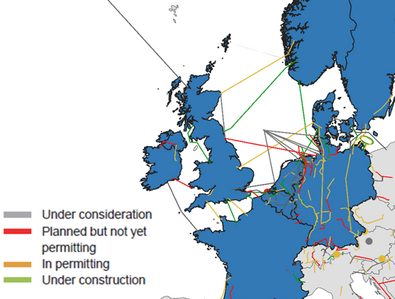Do we really need a mass upgrade of electricity infrastructure at the level we have been told, or even home batteries?
This is probably a question that @transparent can answer...but here goes anyway...
Over on 'the other place' a group of us were talking about batteries and load balancing. We then got onto demand limiting even if you don't have a battery
To summarise the thought process:
- the need for the mass infrastructure upgrade that we are told is an inevitable consequence of electrification (and therefore a direct result of 'net stupid zero' as some would style it) is, at least in the domestic case, driven by heat pumps and BEV charging (and to a presumably lesser extent induction hobs replacing gas hobs)
- neither home heating nor BEV charging is time critical
- the current infrastructure is (presumably) designed to deal with peaks caused eg by everyone switching the kettle on at half time, whilst they roast a chicken in the oven (or something similar)
- so what if we simply, at the house level, switch off BEV charging and heat pumps when these relatively short duration things are happening
- this could be a relatively simple automation (based on sensing house load) and taking advantage of the supply company shut out features that (at least some) heat pumps have and the load limiting features BEV chargers have.
- The sort of thing that can be productized for diddly squat. There is an install cost of course, but with a bit of thought that could be fairly modest or simply done when the BEV/Heat pump is fitted.
- and we can easily enforce it by limiting the main breaker to (say) 60A
- ... and if you want the luxury of running everything at once, then pay a BIG premium for a 100A breaker, so that the rest of us don't have to pay for infrastructure upgrades that are required only for those who want everything (and, in many cases, don't want to pay for anything)
- or alternatively...apparently Belgium already implements tarrifs based on your average usage over 15min, so do something like that
This approach is certainly less resource intensive than distributed batteries, and very likely cheaper than the mass infrastructure upgrade we are told is necessary.
Am I smoking the wrong dope?
4kW peak of solar PV since 2011; EV and a 1930s house which has been partially renovated to improve its efficiency. 7kW Vaillant heat pump.
I recall ages ago reading a report/analysis that worked out how much upgrade we needed based on working exactly as gas. So huge morning and evening peaks adding house heating to 60C with low COP to normal cooking use in the evening/ midday. At the time I didn’t question it, other than reflecting it was not very efficient use of resources of all kinds. (This was before I knew that ashps need long and low).
I haven’t read a recent analysis and it all, obviously, depends on what the authors assume about scope for peak shifting/smoothing by any method.
A recent gov consultation was on remote control of high loads such as heat pumps so that they can be restrained from use during peak demand. The question arises of who does the controlling?
Personally I prefer to do the control myself motivated by time of use (TOU) prices, but that is probably not a mass-market option. The providers of TOU tariffs such as octopus know a lot more than anyone else on this. What percentage of the population change their use profile etc.
2kW + Growatt & 4kW +Sunnyboy PV on south-facing roof Solar thermal. 9.5kWh Givenergy battery with AC3. MVHR. Vaillant 7kW ASHP (very pleased with it) open system operating on WC
Posted by: @judithPersonally I prefer to do the control myself
I agree.
I believe the take up of ToU is quite low, so there will probably have to be both stick and carrot. To date thought processes seem to have been focussed on decentralised carrot (ToU pricing) and centralised stick (forced shut down).
I guess the way the thought process I set out above was going is that there are options to apply stick without centralised control (other than over the breaker capacity). These feel much more acceptable to me than either centralised control or paying for unnecessary upgrades. Combined with some carrot I would have thought it might be possible to make a material difference. Easily linked to the installation of heat pump or BEV chargers too, so not particularly difficult to administer (although necessary to avoid this becoming a blocker to adoption).
4kW peak of solar PV since 2011; EV and a 1930s house which has been partially renovated to improve its efficiency. 7kW Vaillant heat pump.
Another topic on which @transparent will be well able to wax lyrical is that of the local situation.
I seem to remember reading a while ago that the national infrastructure was sized to take into account many huge commercial consumers that no longer exist, meaning a theoretical greater ability to deal with peak loads than might first be thought. Since reading that, it has become obvious those big hitters of old have simply been replaced by different modern ones - data centres, for instance - so I'd guess all bets are off once again with regard to consumption peaks and troughs. Either way, the consumers that completely overshadow even the hungriest of domestic needs are not uniformly placed around the country any more than the power generation facilities. As a result, and I'm sure @transparent has mentioned this more than once before, some parts of the infrastructure are under much greater strain than others, whether because of overly high demands, particularly high or seasonal generation or imbalances of one sort or another.
If there is to be some application of carrot and stick - and I certainly believe there should be - I think it is hugely important to identify which types of strain are prevalent in any given area and therefore what remedy is best to apply. I know this is encroaching on the area of localised pricing (which I know is controversial and on which I haven't formed an opinion either way yet), but it'd seem to me wasteful of resources to, for example, incentivise someone to use less power during peak times if the local problem is excessive generation. I wonder, therefore, how easy it might be to provide a simplified local message for people to say in effect "the overriding issue in your local area is X and the best way for you to help is Y." Carrots and sticks could then be juggled by area more effectively, one would hope.
To quote @jamespa, "am I smoking the wrong dope?"
105 m2 bungalow in South East England
Mitsubishi Ecodan 8.5 kW air source heat pump
18 x 360W solar panels
1 x 6 kW GroWatt battery and SPH5000 inverter
1 x Myenergi Zappi
1 x VW ID3
Raised beds for home-grown veg and chickens for eggs
"Semper in excretia; sumus solum profundum variat"
Posted by: @majordennisbloodnokI wonder, therefore, how easy it might be to provide a simplified local message for people to say in effect "the overriding issue in your local area is X and the best way for you to help is Y." Carrots and sticks could then be juggled by area more effectively, one would hope.
My personal assumption, which I consider to be 'safe' is that everyone acts either purely selfishly or not at all, with the latter forming the majority. Perhaps this is unduly pessimistic but I can't see a system based on people voluntarily doing something altruistic working!
4kW peak of solar PV since 2011; EV and a 1930s house which has been partially renovated to improve its efficiency. 7kW Vaillant heat pump.
You’re not smoking the wrong dope... in fact, you’re puffing on the stuff more people probably should be inhaling when it comes to realistic grid planning.
I think you’ve hit on something really important: a lot of our assumed need for huge infrastructure upgrades is based on unmanaged electrification (everyone charging their EV, blasting the induction hob and firing up the heat pump at exactly the same time). But as you rightly point out, many of these loads are time-flexible, and with even basic demand-side management, the picture changes drastically.
EV charging in particular is low-hanging fruit. Most drivers only need to top up a few kWh per night... that’s a short charge session, easily delayed or scheduled. And heat pumps, when paired with well-insulated homes and thermal mass, don’t need to run full title minute-by-minute. They can pre-heat or coast through short demand peaks.
We already have the tools: EV chargers with built-in load balancing (Zappi etc.), heat pumps with SG-ready inputs or APIs for external control and smart meters with half-hourly data logging. All that’s missing is a joined-up strategy to use them smartly before we dig up roads.
So no, you’re not mad. The real madness is that we’re still acting like the only path forward is gold-plating every cable, instead of investing a fraction of that cost in clever, consumer-friendly demand response.
The big question: will government and DNOs push this kind of solution or keep kicking the infrastructure can down the road?
Pre-order: The Ultimate Guide to Heat Pumps
Subscribe and follow our Homeowners’ Q&A heat pump podcast
Posted by: @jamespaPosted by: @majordennisbloodnokI wonder, therefore, how easy it might be to provide a simplified local message for people to say in effect "the overriding issue in your local area is X and the best way for you to help is Y." Carrots and sticks could then be juggled by area more effectively, one would hope.
My personal assumption, which I consider to be 'safe' is that everyone acts either purely selfishly or not at all, with the latter forming the majority. Perhaps this is unduly pessimistic but I can't see a system based on people voluntarily doing something altruistic working!
That wasn't quite what I was trying to suggest.
My point is that I have no idea whether my local area is being put under greater strain by me either importing loads or exporting loads. At any given time, am I exacerbating a problem or smoothing it out? If I follow your "safe" assumption and act selfishly, it'd be good for me to know what people in my area are being incentivised to do and what actions might carry penalties. Clearly, it seems to me, with parts of the country that are power generating deserts and others that are conspicuous consumers the carrots and sticks could do well to be customised to fit local needs; one size doesn't fit all.
105 m2 bungalow in South East England
Mitsubishi Ecodan 8.5 kW air source heat pump
18 x 360W solar panels
1 x 6 kW GroWatt battery and SPH5000 inverter
1 x Myenergi Zappi
1 x VW ID3
Raised beds for home-grown veg and chickens for eggs
"Semper in excretia; sumus solum profundum variat"
Posted by: @majordennisbloodnokClearly, it seems to me, with parts of the country that are power generating deserts and others that are conspicuous consumers the carrots and sticks could do well to be customised to fit local needs; one size doesn't fit all.
I agee with that.
I suspect however that the structure of the electricity industry and the political nightmare a postcode lottery electricity supply would represent means that, while doubtless technically sensible, it's not going to fly. Hence the suggestion that every house simply limits its own peak, being either incentivised to do so through carrots, or compelled through sticks.
4kW peak of solar PV since 2011; EV and a 1930s house which has been partially renovated to improve its efficiency. 7kW Vaillant heat pump.
You may well be right, @jamespa.
105 m2 bungalow in South East England
Mitsubishi Ecodan 8.5 kW air source heat pump
18 x 360W solar panels
1 x 6 kW GroWatt battery and SPH5000 inverter
1 x Myenergi Zappi
1 x VW ID3
Raised beds for home-grown veg and chickens for eggs
"Semper in excretia; sumus solum profundum variat"
OK... I'm here. But the amount of my time needed to address this is issue is greater than what I have available!
Posted by: @editorThe real madness is that we’re still acting like the only path forward is gold-plating every cable, instead of investing a fraction of that cost in clever, consumer-friendly demand response.
Precisely!
I attended last month's Briefing for those forming the Transitionary Regional Energy Strategic Plan (RESP) body for my area.
The staff based at NESO want us to create the RIIO-ED3 Agreements which are the 'Contracts' between DNOs and Ofgem from April'27 onwards.
However the emphasis is on "ensuring that we're building enough infrastructure" to cope with Demand, and to connect all the generation & storage sites which NESO is busy reassessing at the moment.
There doesn't appear to be space for an alternative to building a massive grid.
That's not good...
... nor particularly Smart.
But anyone can contribute to these tRESP discussions.
You start by sending an email to box.resp@neso.energy
and please say which RESP area you're in.
The detailed maps are at the end of this Decision Notice (PDF) issued by Ofgem.
Posted by: @majordennisbloodnokthe national infrastructure was sized to take into account many huge commercial consumers that no longer exist, meaning a theoretical greater ability to deal with peak loads than might first be thought. [...] As a result [...] some parts of the infrastructure are under much greater strain than others, whether because of overly high demands, particularly high or seasonal generation or imbalances of one sort or another.
Yes. The electricity network topology was designed and built 100-years ago, based on the need for a main Transmission Grid (400kV) with relatively few large power stations.
Big industry users were placed close to that Transmission Grid, whilst the rest of the country was supplied by four layers of voltages on the regional Distribution Grid.
The situation is now very different.
Most of our generation is now connected at the Distribution Grid level.
That's the solar-farms, wind-farms and hydro-electric stations which are required to meet Net Zero.
But
1: the commercial energy sector would still like to invest in a large Transmission Grid because it gives them access to sell 'our' electricity via the marine interconnectors
2: DESNZ has been told by No.10 that they shouldn't move towards Nodal Tariffs (geographically based pricing) because it would favour some constituencies over others.
Posted by: @jamespa
- what if we simply, at the house level, switch off BEV charging and heat pumps when these relatively short duration things are happening
- this could be a relatively simple automation (based on sensing house load) and taking advantage of the supply company shut out features that (at least some) heat pumps have and the load limiting features BEV chargers have
This is roughly what DESNZ is working on under its Demand Side Response project.
However, they intend this to operate using centralised control and a database which amalgamates those commands with our metered energy accounts.
That's not the same as the concept of Demand Side Response which was approved by Parliament in Nov'14 when Smart Meter legislation was being put into law.
Here's a Government public information leaflet about Smart Metering, published two years later
Save energy... recycle electrons!
Currently viewing this topic 2 users ( Old_Scientist, IaAck ) .
Recently viewed by users: Transparent 14 seconds ago.
- 26 Forums
- 2,122 Topics
- 46.6 K Posts
- 47 Online
- 4,529 Members
Join Us!
Podcast Picks
Latest Posts
-
RE: Why do we need pressurised systems?
@toodles Is that because the AI has searched the forum ...
By Old_Scientist , 16 minutes ago
-

OK... I'm here. But the amount of my time needed to add...
By Transparent , 1 hour ago
-
RE: 300 Liter Tank - Do I have to heat it all?
There’s no second hand market for DHW tanks (I was told...
By Judith , 6 hours ago
-

RE: Solar Power Output – Let’s Compare Generation Figures
We had an excellent four months (11/3 to 15/7) generati...
By JulianC , 14 hours ago
-
RE: Is this just haze or something more?
I think the present somewhat cooler hazy days show the ...
By Judith , 20 hours ago
-
RE: My misgivings about installing ASHP and solar panels via the ECO4 scheme...
All noted and accepted and as I say I am sorry that you...
By JamesPa , 22 hours ago
-
I think it is very much me that is sitting outside the ...
By Grantmethestrength , 23 hours ago
-
RE: Replacing Refrigerant on Mitsubishi Heat Pump
@davidalgarve It should just be recovered by both servi...
By dgclimatecontrol , 2 days ago
-

RE: Who's your electricity provider and what's your tariff?
Aggregators have been recognised for many years, and it...
By Transparent , 2 days ago
-
RE: Help me keep the faith with my air source heat pump installation
Great news I edited my previous post (probably af...
By JamesPa , 2 days ago
-
RE: Double or Triple Glazed Windows?
@toodles Glad to hear things are progressing well for y...
By TRBob , 2 days ago
-

How to waste energy (and time) playing with AI.
A friend of mine who subscribes to an AI service was ex...
By Toodles , 3 days ago
-

RE: Heat Pump Books For Beginners – Bodge Buster & From Zero To Heat Pump Hero
@topher you’re more than welcome to, yes. I’ll send you...
By Mars , 4 days ago
-

RE: Fitting new shower valve ..........
I’ve never taken a chance when fiddling and changing ou...
By Mars , 4 days ago
-
You should contact the council and report the unsatisfa...
By JamesPa , 4 days ago
-

RE: Benefits of an extra horizontal loop for GSHP
I would deffo install an additional slinky run, especia...
By Transparent , 4 days ago
-
RE: Say hello and introduce yourself
@editor fab - thanks Mars, and keep up the great work o...
By normpang , 4 days ago
-
RE: Compressor and Evaporator Stratification
@trebor12345 So I think the 1st zigzag section shows so...
By ASHP-BOBBA , 5 days ago







